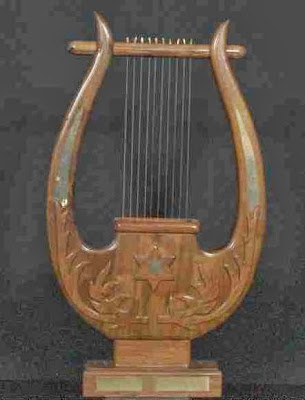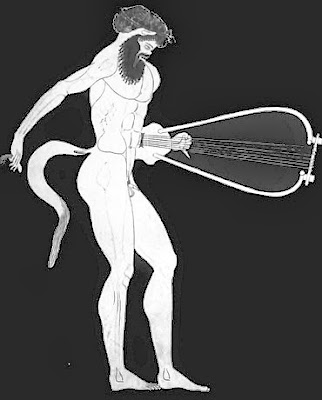The special forms of lyre namely phorminx and the kithara were used more or less by professionals while the ordinary lyre was used for the social life due to its unsuitability of its softness for open air use. The strings of Hermes’ lyre vary but probably four strings were widely used originally and later on increased in number. The tetrachord or the four strings had to be tuned so that the first and the fourth strings could define the interval known as the fourth while the tuning of the other two strings seems uncertain. Towards 670 BC, the tetrachord got expanded with improvement by Terpander who added three strings to the original four strings while the last string of the original string acted as the double duty as well as the first string to the newly added strings together providing a new tetrachord. Mevsh or middle, being the common string, was considered the most important of all the seven strings. Based on standard pitch nowadays, A is considered as 440 vibrations per second and each lyre player tuned the strings to suit their own voice though whichever pitch was taken as fundamental for tonic or base note, the interval between the first and the fourth strings and between the fourth and seventh stings were called a fourth. The second, third, fifth and sixth strings were tuned according to the player and a number of varieties of tuning were used.
Performance was based solely on the ear and if the fourth and the fifth strings of tetrachord could conform to the interval of a fourth, the final results was the ear of the player that established it besides the fundamentals or tonic. Practitioners while committed to the interval of fourth as the basis for their instrument’s structure for performances had another larger interval demanding increased attention by way of octave. The string lengths were related to vibrations and shorter the string, greater was the number of vibrations resulting in higher tone. The Greeks had no means of measuring the vibrations of string but could measure its length and the common practice was to put the higher number first in a musical ratio though it was their custom to sing or play in descending scales while the custom presently is on ascending scales. Here the relationship between two tones is a ratio and the numbers are measured either on string length or vibrations, the ratio of which is called the interval between two tones. Intervals cannot be treated as string lengths and added but they may be combined. Combining ratio and intervals: When a numerical ratio is written as a:b, a, the first term is called the antecedent and b the second term is known as the consequent.
Pythagoras’s general principle has given illustration which shows that the interval which we call octave was defined by ratio 2:1 which means that if a string length was doubled it would define the tone of the octave below or if it was halved it would define the tone above. For scientific purposes, Pythagoras established the octave as the predominant interval and defined that it was the simplest string divisions and multiplications through doubling or dividing and the discovery in the use of the first two integers, 1 & 2, were the results of the most consonant of intervals. The next most natural consonants, the fifth, was defined by the ratio 3:2, and if a given string length is divided into three similar parts, the interval between whole string length and length of two of its part can be known as a fifth. With an interval of octave, it is possible to produce from a higher tone of the octave to a descending fifth which leaves the interval of a fourth i.e. `doh to fah’ and it is observed that an octave has been made up of fifth and a fourth. For the Greeks, the octave and the fifth were natural with pleasing sound to the human ear. In consideration of the lyre, the term octave is used but we do not have the scale eight tones but only seven tones due to the last tone of one string which did double duty as the first tone of the other tetrachord. Pythagoras used intervals to provide steps in the scale and he called a whole tone or just a tone and it was this interval which was used to separate the two tetrachords. With the given array of numbers representing the divided octave: 6 8 9 12 where 6:8 is the fourth and 6:9 is the fifth and the difference between them is the interval of 8:9 being a numerical expression of the whole tone of Pythagoras. Each fourth proposed by him should be divided into whole tones though the fourth will not contain the exact number of the whole tones and it will hold only two whole tones with a smaller interval left being close to a semitone or a half a whole tone with a calculated value of 234:256.
For example:
Let x:y be the left over interval
9:8 compounded with 9:8 compounded with x:y :: 4:3
Or 81:64 cp with x:y :: 4:3
Or x:y:: 4:3cp with 64:81
So x:y :: 256:24
On combining intervals; by multiplying we get
9/8 x 9/8 x 256/243 = 20736/15552 = 4/3
tone tone semitone fourth, and the Pythagorean scale of one octave was made of following intervals -> tone, tone, semitone, tone, tone, tone, semitone,
(first tetrachord) (middle) (second tetrachord)
The arrangement was satisfactory with regards to the practical and ancient traditions of tetrachand though it was within the arithmetical musical division of the octave of Pythagoras. The division of tetrachand was in two whole tones as well as a semitone from which this system derived its name from those tones and was called the diatonic system. Scale or scales was the necessary base for tuning theory and diatonic scales were constructed mathematically or theoretically within the octave with the fifth and the fourth, while there was another method of constructing the scale with only the two intervals of an octave and a fifth, the method of which is known as the Spiral of Fifths. This had the advantage of being empirically tuned.





No comments:
Post a Comment
Note: Only a member of this blog may post a comment.